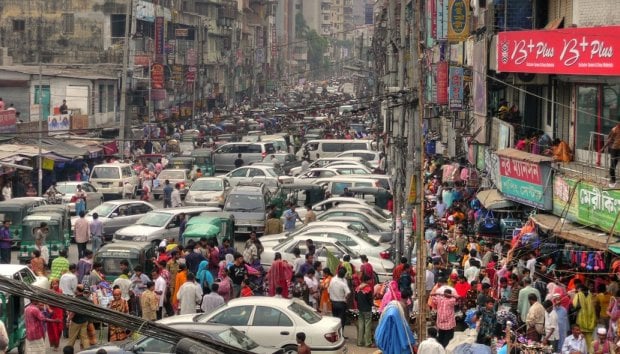When we seek change the temptation is looking for 'the key' component of a problem or situation that, if changed, is expected to lead to profound transformation. Too frequently these type of solutions fail not because the change to the component is poor, but that the thinking is not aligned to the system that contributes to the problem in the first place and thus, changing thinking is what's actually the key not the designed solution.
If you're one of the millions of people who made a New Years resolution there is a very good chance that your resolve has already wavered if not been completely abandoned. Research shows that New Years resolutions simply don't hold up. This is not because of lack of will or even lack of effort or thought, but because we often confuse changes in a part of the system (e.g., exercise and better diet) with changes in the system itself (overall better health and weight loss).
Travel might be the ultimate example of systems and change. For the scenario pictured above, having a better automobile does nothing to help navigate the streetscape. No amount of fuel efficiency, top speed, safety rating or performance tires are going to make an ounce of difference in traversing this space. The reason is that the transportation system is broken, not that the units within it are. Indeed, cars, bikes, rickshaws and foot all perform perfectly well in this environment as designed, yet are rendered disabled in this context, which was designed to facilitate, not hinder their use.
Collective impact, systems change?
The model of collective impact is one that recognizes the fallacies of assuming that organizations seeking transformative social change will do so on their own, independently through wise thought and action. Collective impact is a model that has been widely supported by organizations such as Tamarack as a means of building capacity for systems change, not just change in the system.
The concept of collective impact was first popularized by John Kania and Mark Kramer in an article in the Stanford Social Innovation Review. Collective impact is a specific set of strategies that align the following five qualities and brief summaries that follow:
- Common agenda (are organizations striving for the same things?)
- Shared measurement systems (are partners measuring the same things in the same ways to enable comparisons and combine data?)
- Mutually reinforcing activities (are initiatives building on one another, syncing up, and coherent?)
- Continuous communication (are partners 'in the know' about what is happening across the system as activities unfold? )
- Backbone support organizations (is there an organization or more that provides coordinating support and infrastructure to maintain the whole enterprise?)
The concept of coordinated action toward a common goal supported by shared means of assessment and feedback and ongoing communication is an enormous step forward in organizing actors involved in social change initiatives.
What is often missing from the discussion of collective impact is systems thinking. That is, explicit discussion of the way systems operate and not just discussion of the system itself that is to be changed. To be clear, there are many ways of doing collective impact and I mention Tamarack because they are among the few organizations that bring systems thinking into their work on systems change and collective impact. But it's important to note that this is an exception, not the rule when reviewing what's out there on collective impact. Many organizations do not (or may not) realize that thinking about systems change is not the same as systems thinking.
It is quite possible that we could see collective impact produce a larger-scale version of the flaws we see in initiatives aimed at changing components of the system if systems thinking isn't considered integral to how its implemented. No amount of communication or shared measurement will help if we don't measure the right things.
Systems thinking about collective impact
Social change is not doing the same thing that works at one scale (e.g. a person, family or team) and simply doing a lot more of it in more places. There are corollaries to be sure, but it's not a linear pathway. Just as scaling a challenge and the response to it up produces potential for benefits, it also can scale harmful (or limiting) effects if the problem is not well-defined.
With that, let me pose some questions and challenges for those engaging in collective impact to help advance our shared understanding that are rooted in systems thinking?
- What is the problem that is aimed to be solved (and is it the real problem?) Have alternative viewpoints from a diversity of actors throughout the system been considered in light of their position within the system and the values, goals and aspirations of those seeking systems change?
- One of the ways that this diversity of perspectives is gained is through systems mapping. Systems mapping can be done through many different methods with each producing different looks at the dynamics, structures and relationships within the system. But what is shared is that it visualizes these qualities in a manner that makes it accessible to (almost) everyone. It allows for participants in the process to ask questions like: "why is [x] located so close to [y]?" or "where is [z] in all of this?" These create the kind of discussions that allow assumptions to emerge about the dynamics of the system itself.
- An important follow-up to this is tracking these issues and framing them as evaluation questions. This grounds some of the metrics and measures in the system itself, not just the activities that the participants in collective impact initiatives seek to perform. It can also recognize the limits of the organizations at the table and either better account for them or provide guidance on how to overcome them (e.g., recruit more or different partners).
- Systems maps are not only useful at the beginning, but can be an evaluative tool in itself. Maps developed at the start of an initiative and at different time points can enable partners to see what has changed and potentially find out how by examining how the structures, relationships and inclusion or exclusion of certain parts of the system shift over time. It may not allow for explicit causal attribution, but it can help understand and document what changed and initiate collective sense making about how that might have happened.
This is just a sample of the questions that systems thinking starts to get us doing. Systems thinking encourages us to question how we bound a system (what's in and out) and what happens within those boundaries recognizing that there are many different positions within that system that change how we perceive it -- and what is considered problematic or not.
If we consider the traffic problem posed at the start of this post, one might find that the system problem isn't even one related to the street, but to the larger community. One may find that the distances or locations of places to work, worship, shop and play are misaligned or that there are times of days when certain activities bring people into the street or perhaps its related to temperature (too hot, too cold) and the absence of climate control systems that work. More importantly however, systems thinking may enable us to account for all of these at the same time and avoid us focusing on one or two problems, but the system as a whole avoiding what is known as "a fix that fails".






